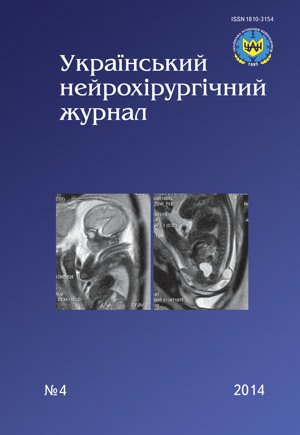Role of stereotactic radiosurgery in treatment of patients with posterior fossa meningiomas
DOI:
https://doi.org/10.25305/unj.46599Keywords:
posterior fossa meningioma, stereotactic radiosurgeryAbstract
The purpose. To analyze treatment results of patients’ with posterior fossa meningiomas using stereotactic radiosurgery (SRS), to estimate efficacy of the method.
Materials and methods. SRS, using linear accelerator «Trilogy + BrainLab» was performed in 51 patients with posterior fossa meningiomas. The target’s volume ranged from 0.85 to 19.2 cm3, the marginal dose — from 11 to 15 Gy, target’s volume, received the marginal dose — from 81 to 100%, maximum dose — 12.7–20 Gy. 36 patients were followed from 2 to 36 months, in average 12.3 months after treatment.
Results. According to SRS efficacy estimation and neurological status there was no dynamic in 88.9% patients. MRI results showed tumor decrease in 44.4% cases, it’s stabilization — in 52.8%, tumor’s growth control was achieved in 97.2% patients.
Conclusions. SRS is an effective and safe method of treatment of posterior fossa meningiomas, providing high rate (97.2%) of tumor’s growth control and ensuring high quality of patients’ life (Karnofsky index over 80).
SRS with lower marginal doses (12–12.7 Gy) reduces frequency (in 88.9% cases) of transient and permanent neurological deficit, without changing conditions for tumor’s growth control.
References
Starke R, Nguyen J, Rainey J et al. Gamma Knife surgery of meningiomas located in the posterior fossa: factors predictive of outcome and remission. Journal of Neurosurgery. 2011;114(5):1399–1409. CrossRef
Javalkar V, Banerjee A, Nanda A. Posterior Cranial Fossa Meningiomas. Journal of Neurological Surgery Part B: Skull Base. 2012;73(01):001-010. CrossRef
Starke R, Williams B, Hiles C, Nguyen J, Elsharkawy M, Sheehan J. Gamma Knife surgery for skull base meningiomas. Journal of Neurosurgery. 2012;116(3):588-597. CrossRef
Combs S, Ganswindt U, Foote R, Kondziolka D, Tonn J. State-of-the-art treatment alternatives for base of skull meningiomas: complementing and controversial indications for neurosurgery, stereotactic and robotic based radiosurgery or modern fractionated radiation techniques. Radiat Oncol. 2012;7(1):226. CrossRef
Minniti G, Amichetti M, Enrici R. Radiotherapy and radiosurgery for benign skull base meningiomas. Radiat Oncol. 2009;4(1):42. CrossRef
Kreil W. Long term experience of gamma knife radiosurgery for benign skull base meningiomas. Journal of Neurology, Neurosurgery & Psychiatry. 2005;76(10):1425-1430. CrossRef
Pollock B. Stereotactic radiosurgery for intracranial meningiomas: indications and results. Neurosurgical FOCUS. 2003;14(5):1-7. CrossRef
Iwai Y, Yamanaka K, Ikeda H. Gamma Knife radiosurgery for skull base meningioma: long-term results of low-dose treatment. Journal of Neurosurgery. 2008;109(5):804-810. CrossRef
Dincoglan F, Beyzadeoglu M, Sager O, Uysal B, Demiral S, Gamsiz H, Dirican B. Evaluation of linear accelerator-based stereotactic radiosurgery in the management of meningiomas: a single center experience. J BUON. 2013;18(3):717-22. PubMed
Larson D, Flickinger J, Loeffler J. The radiobiology of radiosurgery. International Journal of Radiation Oncology*Biology*Physics. 1993;25(3):557-561. CrossRef
Downloads
Published
How to Cite
Issue
Section
License
Copyright (c) 2014 Irina Kruchok, Olga Chuvashova, Lyudmila Verbova

This work is licensed under a Creative Commons Attribution 4.0 International License.
Ukrainian Neurosurgical Journal abides by the CREATIVE COMMONS copyright rights and permissions for open access journals.
Authors, who are published in this Journal, agree to the following conditions:
1. The authors reserve the right to authorship of the work and pass the first publication right of this work to the Journal under the terms of Creative Commons Attribution License, which allows others to freely distribute the published research with the obligatory reference to the authors of the original work and the first publication of the work in this Journal.
2. The authors have the right to conclude separate supplement agreements that relate to non-exclusive work distribution in the form of which it has been published by the Journal (for example, to upload the work to the online storage of the Journal or publish it as part of a monograph), provided that the reference to the first publication of the work in this Journal is included.









